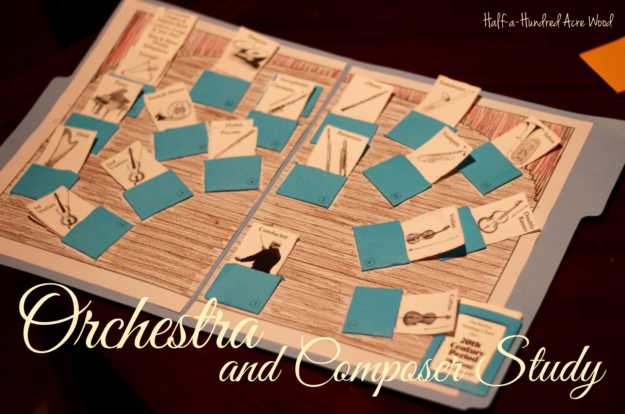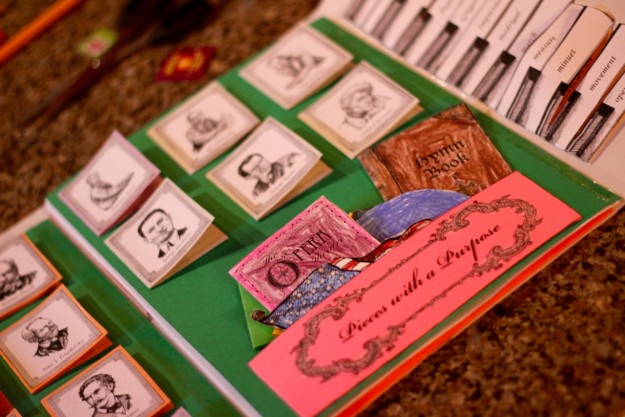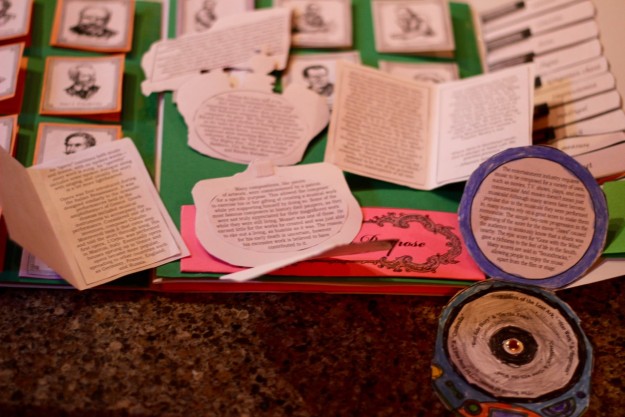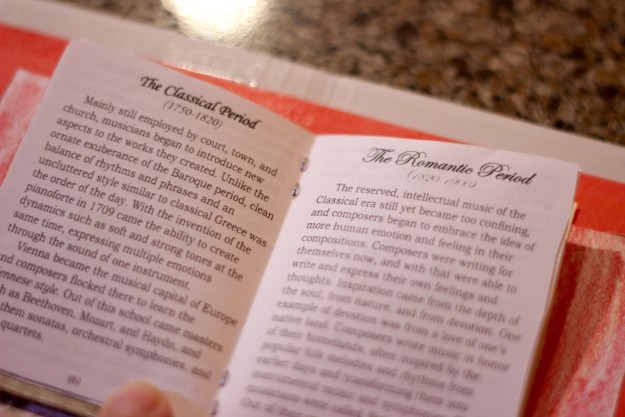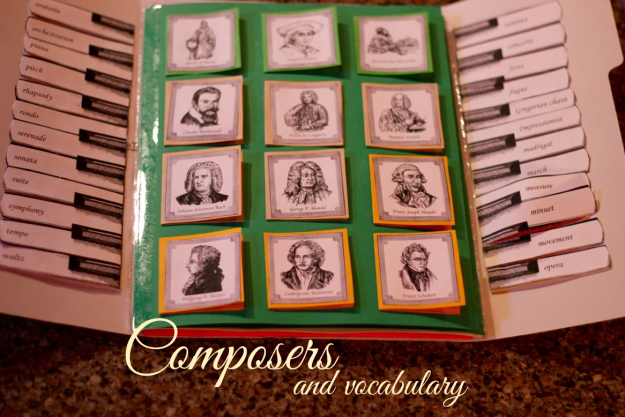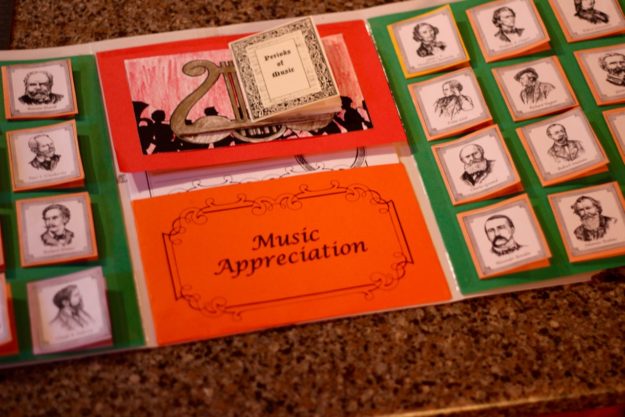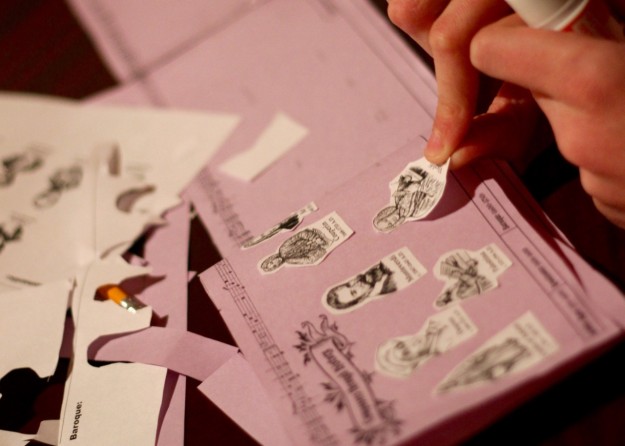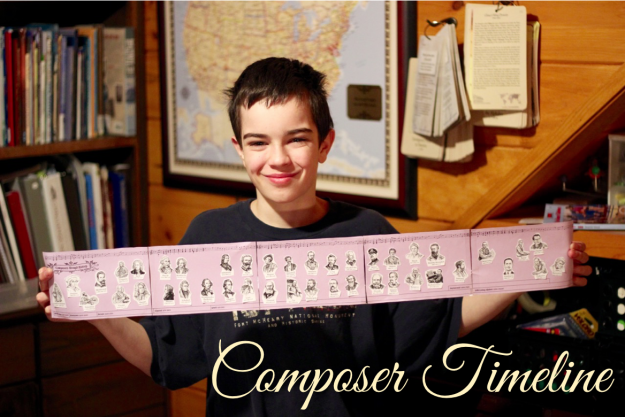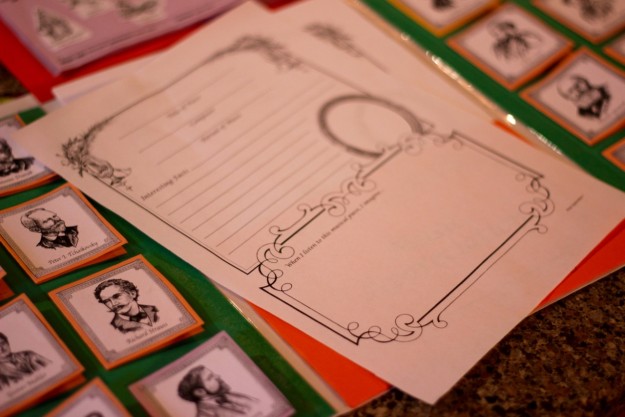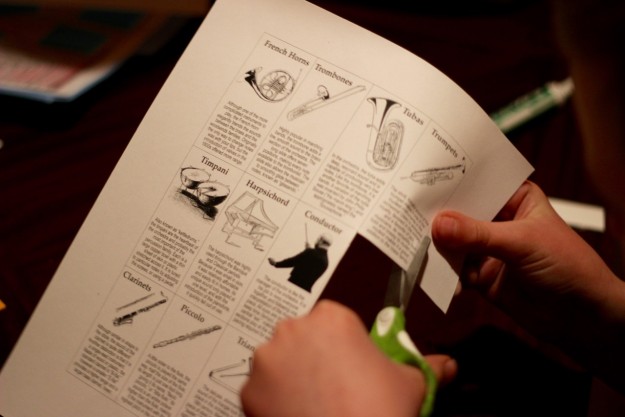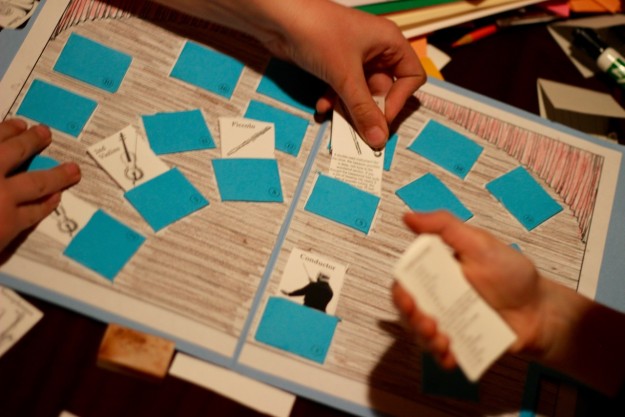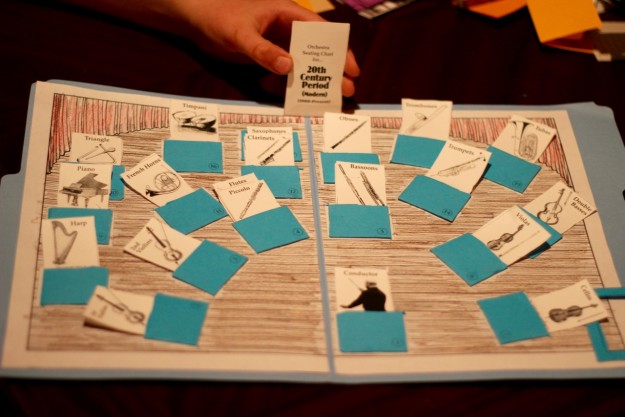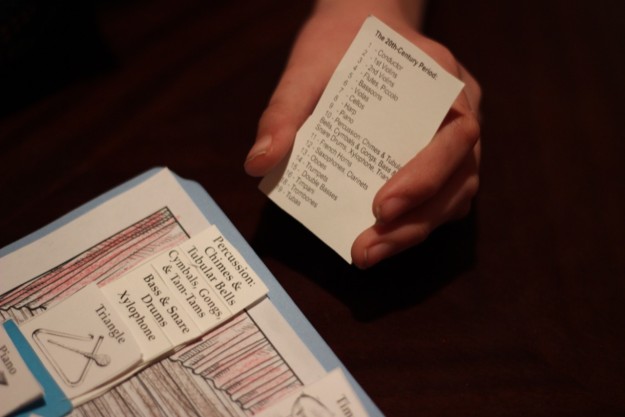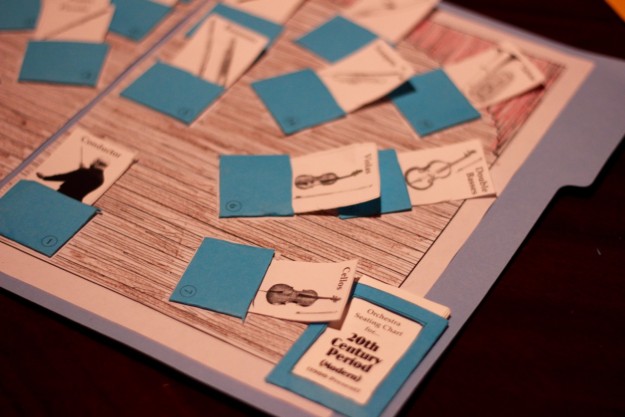Earlier this week I mentioned my big ole bucket of Truth, Goodness, and Beauty intentions and how tough it can be to incorporate these vital elements into our homeschool during this particular season of our lives. Now I’d like to share a tool that has made it easier for us to enjoy a bit of classical music study without adding stress to our day. (Because… well, it makes little sense to incorporate truth, goodness, and beauty if it adds a bunch of stress in the process, right?)
So here we go. Let me introduce to you the…
Hands-On History Activity-Pak for Composers
The Composer Study from Homeschool in the Woods is a downloadable packet that includes activities to help students explore and understand the historical significance of classical music…
…while introducing them to the details of the various periods…
…along with opportunities to research composers and vocabulary…
…as they dive into music appreciation.
This Hands-On History Activity-Pak is a long-term study which provides a framework for studying various periods of classical music (from the Middle Ages to Modern) with 42 composers:
- Guido of Arezzo
- Bach
- Mendelssohn
- Gounod
- Balakirev
- Sousa
- Ravel
- Bernstein
- Verdi
- Deprez
- Handel
- Chopin
- Smetana
- Mussorgsky
- Mahler
- Stravinsky
- Barber
- Debussy
- Palestrina
- Haydn
- Schumann
- Strauss II
- Tchaikovsky
- Strauss (Richard)
- Prokofiev
- Vivaldi
- Schubert
- Monteverdi
- Mozart
- Liszt
- Borodin
- Dvorak
- Beach
- Gershwin
- Cui
- Rimsky-Korsakov
- Couperin
- Beethoven
- Wagner
- Brahms
- Grieg
- Rachmaninov
(For Classical Conversations families, it includes timeline figures and lap book pieces for all nine of the composers in the three cycles of the Foundations program.)
Man, I love Homeschool in the Woods’s timelines. They are so fantastic!
In addition to the timeline and research activities, this study includes music files in mp3 format for 29 different pieces and movements:
- Vivaldi, Gloria in Excelsis Deo Concerto in E Major, Four Seasons: Spring – 1st Movement, Four Seasons: Summer – 3rd Movement
- Bach, Sleepers Awake Cantata 140 – 4th Movement, Concerto in C minor for violin and oboe (3rd Movement: Allegro), Air on the G String from Orchestral Suite No. 3 in D major, Brandenburg Concertos No.3 – i: Allegro Moderato
- Handel, La Rejouissance (The Rejoicing) from “Royal Fireworks,” Hallelujah Chorus from “Messiah”
- Mozart, Concerto for Piano and Orchestra no. 23 in A major – 2nd Movement, Eine Kleine Nachtmusik (A Little Night Music) – 1st Movement
- Beethoven, Sonata No. 8 “Pathétique” – 2nd Movement: Adagio cantabile
- Schubert, Ave Maria (Cello and Harp)
- Mendelssohn-Bartholdy, Bridal Recessional from “A Midsummer Night’s Dream”
- Chopin, Les Sylphides (orchestrated by Alexander Glazunov), Waltz in D flat major opus 64 (Minute Waltz)
- Schumann, Arabesque, op. 18
- Liszt, Liebestraum No. 3 (Dreams of Love)
- Wagner, Here Comes the Bride, from the opera “Lohengrin”
- Strauss II, Blue Danube Op. 314
- Brahms, Symphony No. 1 in C minor – 4th Movement Op. 68
- Mussorgsky, Pictures at an Exhibition – Promenade, (orchestrated by Maurice Ravel)
- Tchaikovsky, an exerpt from Swan Lake, Nutcracker Suite – Overture
- Grieg, Peer Gynt Suite No. 1 Op. 46 – 1st Movement (Morning Mood), Peer Gynt Suite No. 1 Op. 46 – 4th Movement (In the Hall of the Mountain King)
- Rimsky-Korsakov, Flight of the Bumblebee from the opera “The Tale of Tsar Saltan”
- Debussy, Arabesque #1
- Ward, America the Beautiful words by Katherine Lee Bates
Using the notebooking templates provided (along with corresponding composer images), students can record interesting facts and illustrate their thoughts as they listen to each piece.
Twenty Composers Cards (not pictured because I forgot to take a photo of those!) match some of the composers with their information and popular works, which provides a means for drilling or playing games as students become familiar with the music and the masters.
Last (but certainly not least) this study packet includes an interactive orchestra seating chart, which includes cards with information about the various musical instruments.
I can’t even describe how very, very cool this is. Our two middle children who don’t normally enjoy lapbook-y type stuff are all over this thing! They love reading about the instruments and changing out the arrangement based on the instructions provided on the back of each orchestral-period card. They can really grasp how the orchestra grew and read about various instruments that were added to the orchestra through the years – it’s so much better than the on-line interactive games I’ve had them experiment with in the past! (And… this interactive seating chart is available as a separate purchase for those just wanting to introduce this part of orchestra study.)
How we’re using this composer study
Now that we’ve constructed the lap book and have all of the pieces ready, we are going through the composers one at a time, spending a week or two on each of the 19 composers for which this activity pack includes music. As it stands right now, we are not planning to do much research, although we may end up reading about the composers from The Gift of Music, A Child’s Introduction to the Orchestra : Listen While You Learn About the Instruments, the Music and the Composers Who Wrote the Music!, or Lives of the Musicians. Even if we don’t get around to that part of composer study right now, I’m glad to have a broad range of classical music from which to pull together our morning wake-up playlists!
My two cents
This study covers dozens of composers across the major periods of classical music and provides a great birds-eye overview of the importance of the classical music to Western Civilization. This packet includes detailed, step-by-step illustrated directions for printing and assembly of all lap-book and file folder orchestra seating chart components, along with photos of completed projects for reference. Students (and parents) who enjoy hands-on activities will enjoy this study as they learn about orchestra and composers. If you are a family who is not so fond of hands-on activities, simply having the collection of classical music and notebooking pages along with the recommended reading lists provides an easy way to incorporate some music appreciation into your school days. The flashcards are pretty handy, too!
This particular study does not take nearly as much printing and preparation as some of the other Homeschool in the Woods studies. We spent two evenings piecing together all of the different components (although we didn’t fill them all out yet – we just prepared the pieces to be filled out as we study each composer/era).
I wish this study included a short biography or story about each composer mentioned in the packet. (Yeah, 42 biographies is all I’m asking. 😉 I’m afraid I’ve been spoiled by the Homeschool in the Woods Time Travelers and Project Passports series!) I also would love to have at least one musical snippet from all 42 composers. But I only think to ask that because they gave us 29 music downloads! (ha!)
Overall, this is a great product to provide a framework for composer, orchestra, and classical music study to use in your home for months!
Would you like to try a couple of the activities in the Composer Activity Pak or Artist Activity Pak? You can purchase the games as separate alacart options at the following links:
Art Gallery Game
Interactive Orchestra Seating Chart
Learn more about the Artist Activity Pak at our post on Art Appreciation through Art History.
Over the years, we’ve continued to find ways to work these studies into our schedule – either over breaks, over weekends, or on an occasional afternoon. We enjoy them so much! To see other Hands-on History Studies we’ve completed, visit:
Timelines: Studying History through the Ages
Using Homeschool in the Woods Timelines for Challenge
Artists Activity Lap Pak
Studying World War II
Composer & Orchestra Study
Homeschool in the Woods 20th Century Lap Pak
New World Explorers: Columbus and the Age of Exploration
Colonial Life: Handicrafts in History Studies
American Revolution Study
Early 19th Century Study
Civil War Study
Benjamin Franklin Unit Study (for grades K-2)
Renaissance & Reformation by Homeschool in the Woods
Middle Ages Project Passport by Homeschool in the Woods
Homeschool in the Woods New Testament Activity Pak
Industrial Revolution through the Great Depression
If you have questions about any of them, be sure to leave a comment or send me an email! We’d love to hear from you!
I received this product in exchange for a review. These thoughts are my very own and haven’t been influenced by anyone or anything else. This posts includes affiliate links. To read our full disclosure, click here.

